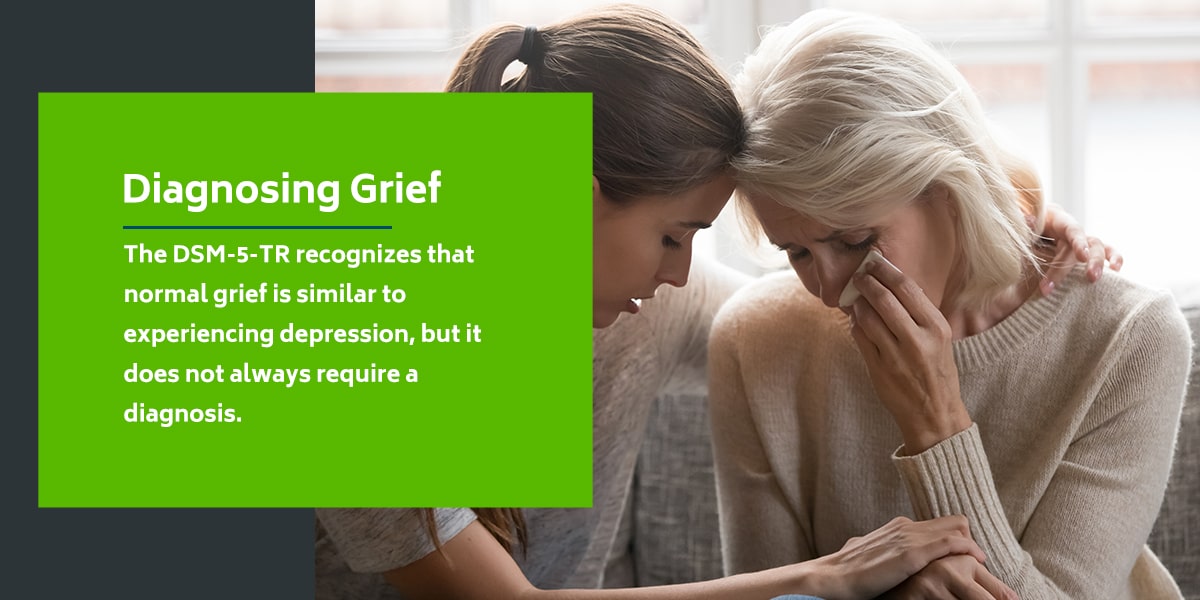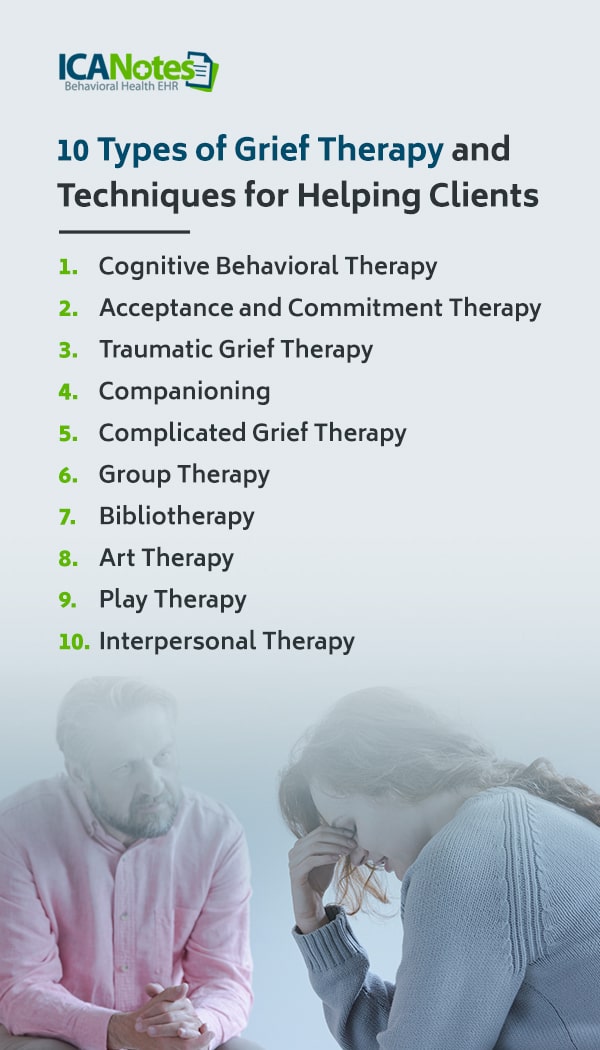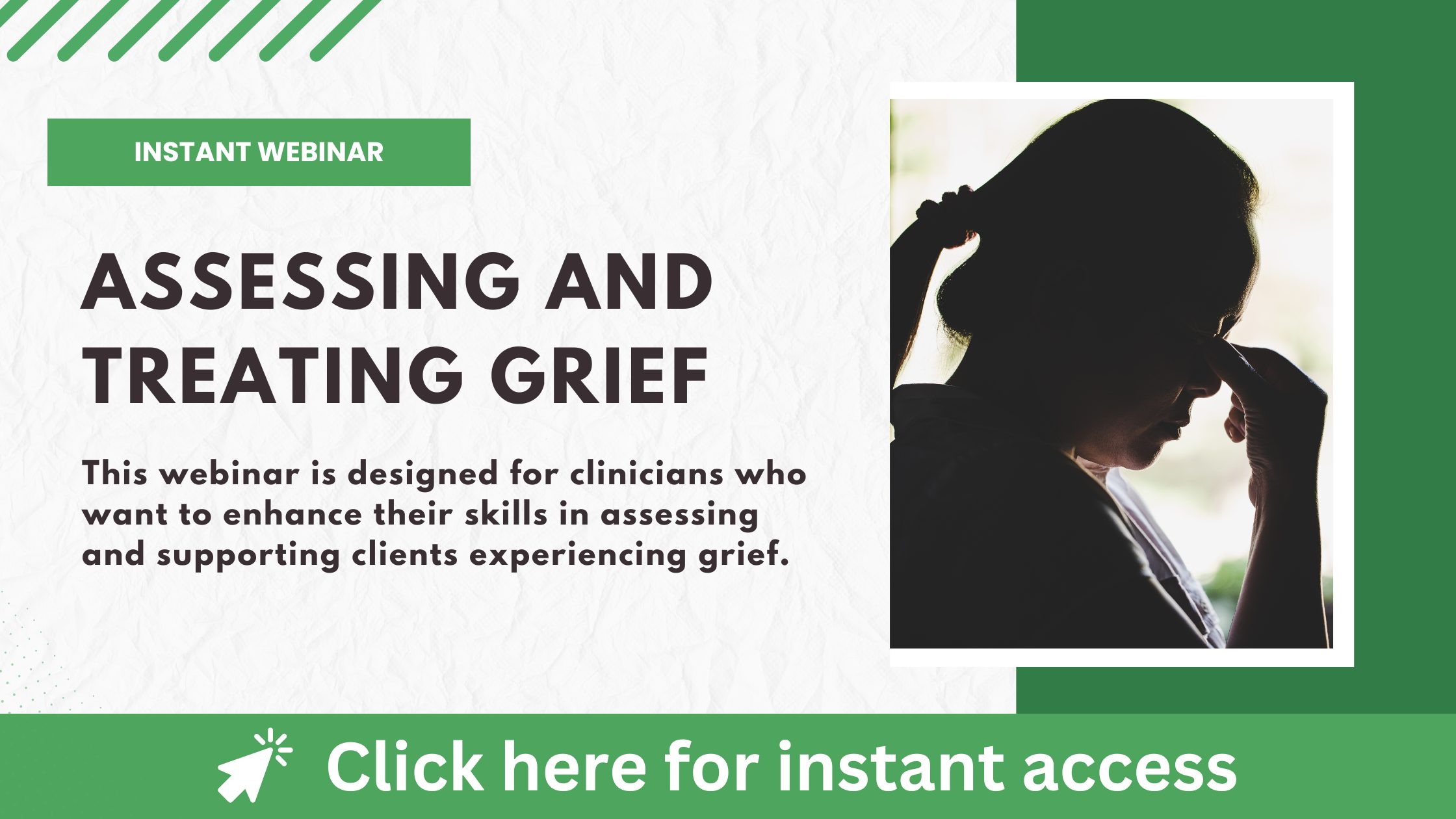
Grief Treatment Plans
Grief is a universal experience. Within each of our lifetimes, we will experience losses that trigger grief to varying degrees, impacted by a number of unique factors, from person to person, and loss to loss. Due to the wide range of intensity around each grief experience, many individuals are able to engage with natural support systems and do not seek professional mental health services. The need for professional support is not as clear cut as you may think. Some individuals will seek support due to intense feelings of hopelessness and anhedonia, others due to an overall lack of natural social supports, and others will find that grief support is needed among additional mental health concerns already being addressed by a professional.
As a therapist or counselor, your job is to support individuals in grief as they navigate their complex feelings associated with the loss, adjust to life without the deceased, and encourage a re-engagement into life while maintaining a lasting connection with the person who has died. While there are some modalities and strategies to supporting anyone who is experiencing grief, such as William Worden's Four Tasks of Mourning, or Elizabeth Kubler-Ross' 5 Stages of Grief, there may be times when a higher level of intervention may be needed due to issues with persistent complex bereavement, disenfranchised grief, and underlying mental health conditions triggered by grief, such as trauma and clinical depression. This guide will examine the different types of grief and how you can develop a customized treatment plan for each client's unique needs.
Access Our Sample Treatment Plan Library
Get instant access to our full library of sample treatment plans.


What is Grief?
Grief is a term used to describe the feelings, behaviors, and thoughts someone experiences due to the loss of something or someone close to their heart. When you hear the term “grief,” you likely think of losing a loved one. This is the most common loss associated with grief, however grief can be experienced through the loss of something meaningful to a person. This may include, but is not limited to job loss, the diagnosis of a life-limiting or terminal illness, divorce or other loss of a relationship, aging, and mobility.
Each of these losses, whether they are publicly recognized as loss or not, contain feelings of grief and mourning. Grief is the internal feeling associated with grief, while mourning is the external expression of those internal feelings. These two experiences combined make-up a term we call "bereavement." Due to the complexity of each grief process, it is impossible to clearly define a grief reaction that is standard across all bereaved individuals. However, to support health professionals in navigating grief work, we tend to group grief types into the following categories:
Acute Grief
Acute Grief occurs within the first several months following the death of a loved one and consists of intense symptoms, such as:
- Sadness and guilt
- Restlessness
- Sleep problems
- Feelings of numbness or shock
- Distress that leads to physical discomforts, such as shortness of breath
- Poor concentration
These symptoms are a common part of the grieving process and typically resolve over time, with the support of family members, engagement in support groups, and by enlisting the care of a grief counselor. With acute grief, clients should still experience intermittent moments of happiness, such as laughter or enjoyment. As the experience of the loss becomes further away chronologically, typical grief symptoms tend to become less frequent and intense. However, if over time an individual's grief reactions become more intense, this may be a sign of complicated grief, which would warrant further clinical treatment.
Integrated Grief
As someone begins to heal from their initial, acute grief, they may transition into integrated grief. At this stage, they may resume their daily routines and activities as the intense pain of grief begins to subside. While the sadness of losing a loved one does not disappear, the bereaved person gradually learns how to integrate the loss into their daily life.
While experiencing integrated grief, they may express feelings akin to acute grief, experiencing intense symptoms they originally thought they had moved past. This is a normal part of the process and tends to happen around significant events, such as the loved one's birthday, anniversary, or holidays. This experience may be distressing to the bereaved individual, and appear to be a symptom of regression, however, grief is not a linear experience. It is completely normal for one to oscillate between feelings of deep grief to feelings of peace. Integrated grief represents the process of "integration" of feelings of loss while engaging in life to a point where the symptoms are no longer debilitating.
Complicated Grief
Complicated Grief is the result of a set of factors that inhibit an individual from integrating their loss and resuming life after the death of a loved one. This type of grief brings on symptoms of acute grief for extended periods after losing a loved one. Often, they may experience frequent, debilitating memories of the deceased love. This may also be accompanied by strong feelings of survivor guilt and wondering what they could have done to prevent the death from occurring. Other times, they may feel that enjoying their life and returning to their usual activities is a betrayal. Complicated grief can occur if:
- The deceased was very young, such as a child.
- The loss was violent, unexpected, or provided no closure.
- The client has little social support.
- The client has experienced child abuse, neglect, or unhealthy relationships.
- The client has a history of anxiety or mood disorders.
- The relationship between the deceased and the bereaved was complicated.
Common signs of Complicated Grief include physical and emotional symptoms, such as:
- Anger and resentment
- Anxiety, insecurity, and helplessness
- Depression
- Feelings of emptiness
- Passive suicidal ideation
- Shock, disbelief, and denial
- Fatigue
- Headaches
- Significant weight loss or gain
- Insomnia
- Frequent and excessive crying
- Nausea or loss of appetite
- Difficulty concentrating
While experiencing several or many of these symptoms is a sign of healthy grieving, if a client experiences them excessively or intensely, they may benefit from grief therapy or counseling techniques.

Diagnosing Grief
10 Types of Grief Therapy and Techniques for Helping Clients
Just as people experience different types and symptoms of grief, they also process grief in many ways. Grief therapy techniques help mental health professionals provide various approaches to dealing with the loss of a loved one, relationship, or any other significant loss in someone's life. The therapy technique that will work best for your client depends on several factors. Sometimes, combining grief therapy tools and techniques may offer a more effective outcome. Let's look at some methods you can use in grief counseling.
1. Cognitive Behavioral Therapy
Cognitive behavioral therapy is a method used in many circumstances to help clients identify negative thought patterns and learn how to change their behavior. The learning outcome of CBT is to help people process grief, understand how their thoughts affect their behavior, and guide them to live healthier lives. With CBT, you and other mental health professionals can:
- Identify and address unhelpful behaviors or harmful habits
- Introduce healthier, positive ways to cope
- Develop a new narrative surrounding the loss of a loved one
- Establish cognitive restructuring to change negative thought patterns
2. Acceptance and Commitment Therapy
As a therapist or counselor, you can use acceptance and commitment therapy to help your clients accept the negative emotions they feel instead of avoiding or feeling guilty about them. This technique can help people embrace their psychological flexibility, making it easier for them to be present in their lives and develop healthier patterns. The ACT method involves using mindfulness to process grief and achieve acceptance and healing by:
- Identifying personal values
- Overcoming difficulties

- Accepting negative feelings
- Focusing on the present
- Embracing confusion, happiness, and pain without looking to control or change these feelings
- Observing yourself experiencing negative emotions and situations to better understand them
3. Traumatic Grief Therapy
Some cases of grief also involve trauma, which can result from an unexpected or violent death or even being present and witnessing the loved one as they passed. Trauma can often mask grief and make it difficult to accept the feelings or go through the normal grieving process. Traumatic grief therapy focuses on the trauma response alongside the grief itself, disentangling the two emotions to help the client heal.
4. Companioning
As a therapist, you may have worked with clients who needed someone to listen to them and validate their feelings. Companioning is a form of grief treatment focused on that. Rather than trying to analyze or “fix”’ the client's situation, a companioning therapist is present and provides a safe space for people to express their thoughts and emotions and feel supported. This style of grief support mirrors walking alongside someone in grief, rather than a typical therapy session.
5. Complicated Grief Therapy
As mentioned above, complicated grief can often bring back intense symptoms associated with acute grief and cause someone to feel that they've regressed in their grieving process. Complicated grief therapy helps clients address these symptoms of severe, prolonged sadness or hopelessness and accept that these emotions are a natural part of losing a loved one. Complicated grief treatment often combines with ACT methods to help clients who may fixate on the loss or the circumstances surrounding the death.
6. Group Therapy
Group therapy is a technique for people who can benefit from sharing their thoughts and feelings with others who are in a similar situation. Group therapy can be effective for grieving clients who lack a support system. They can listen to others in various stages of their grieving process and learn how to recover from a similar experience. This therapy may also help clients consider others' perspectives and understand that the guilt or sadness they feel is normal.
7. Bibliotherapy
As with group therapy, some people may benefit from reading about shared experiences of grief from another person's point of view. With bibliotherapy, you can encourage your clients to read about stories of loss, bereavement, or even trauma-related grief to learn how others have worked through these emotions and life experiences. Bibliotherapy can help clients feel validated in their fluctuating symptoms and supported as they start their healing journey.
8. Art Therapy
Bereaved people need to find purpose in their day and continue to embrace new activities. Using art therapy, you can promote creativity and healing in your clients as they process grief. Many people use various forms of art to express and regulate their emotions, and art therapy is no different. Artistic and creative self-expression, such as through coloring, drawing, painting, or making collages, may heal your client and inspire them to see the beauty in life again.
9. Play Therapy
Like art therapy, play therapy generally focuses on helping children process grief. If you are treating a child who has recently lost a parent or close loved one, play therapy can help them use their imagination to express their feelings and learn to self-regulate their emotions. Play therapy may involve storytelling, playing with puppets, or similar games involving toys. After a significant loss, teaching children to express themselves and have an outlet can make it easier for them to begin healing.
10. Interpersonal Therapy
This therapy technique aims to clarify a client's relationships with others in their life. One of the goals of interpersonal therapy is to release repressed emotions to learn how to stop avoiding them altogether. As a counselor or therapist, you can encourage your client to talk about their relationship with their deceased loved one, including the circumstances leading up to and following their passing.
You can also ask your client to speak honestly about their memories of their loved ones and how the event has affected their relationships with others. For instance, some grieving people may pull away from their significant other, friends, or family and self-isolate.
Goals of Grief Treatment
As with any other treatment plan you develop for your client, grief treatment plans should include specific, measurable objectives you and your client wish to accomplish throughout your sessions together. Here are some examples of goals you can focus on setting during grief treatment.
- Increased understanding of loss: Your client will learn how to describe their feelings, identify issues, gain awareness, and establish steps to manage grief through the use of coping skills.
- Validate the past: Your client will recognize that there is no "right or wrong way" to grieve and that the process is ever-changing. They will validate their past with their loved ones by creating new life experiences, gaining emotional support, and forging healthy relationships.
- Accept responsibility for change: Address underlying feelings of grief and learn to resolve or let go by accepting the change.
- Decrease extreme grief: Reduce the potential for harmful behaviors relating to grief and loss, such as substance abuse or disordered eating, and learn healthy coping techniques to address feelings.
- Challenge irrational thinking: Challenge irrational or unreasonable thoughts with reality and identify specific areas of distortion relating to past grief and loss.
- Address uncomfortable feelings: Deal with sadness, “what-ifs” and survivor guilt resulting from grief and loss.
Keep Your Grief Treatment Plans Organized with ICANotes
As a mental health professional, thoroughly understanding grief can prevent you from overtreating healthy symptoms while identifying warning signs. Grief comes in many shapes and sizes, so it's vital to keep all sessions with your clients well-documented so you can monitor their progression and determine if they need clinical intervention or treatment adjustments.
With ICANotes, you can equip yourself with the behavioral health tools and templates you need to keep your session notes and treatment plans legible, well-organized, and ready for sharing with other professionals if needed. Our clinically robust and intuitive mental health EHR software can reduce the time you spend on documentation, help you maintain compliance, and empower you to deliver more comprehensive care. Contact us today at 443-347-0990 for more information or request a free trial online.
Start Your Free Trial Today. No credit card required!
About the Author

Kaylee Kron, LMSW, Certified Grief Counselor
Kaylee, a certified grief counselor and social worker, has dedicated the past decade to reshaping our understanding and support of grief. With experience at a nonprofit hospice, she's empowered individuals to navigate their grief journeys, recognizing that loss extends beyond death. As an author, speaker, and event organizer, Kaylee fosters spaces for acknowledging and embracing life's most challenging moments. Her work has been featured across various media, amplifying voices and broadening awareness of the diverse sources of grief in our lives.












